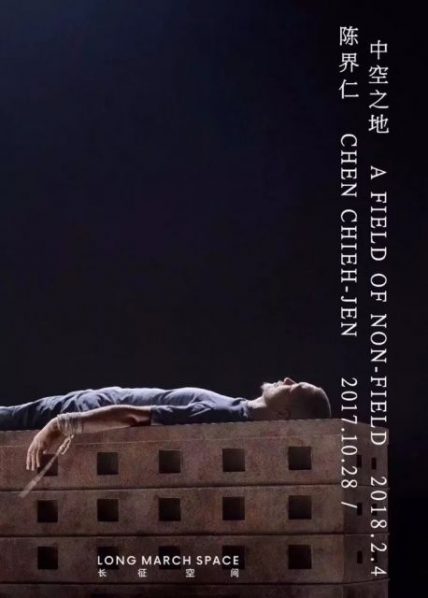
“A Field of Non-field” will be the second solo show of Chen Chieh-jen to be held in Long March Space after 7 years. In 2010, for the solo show “Empire’s Borders”, Chen Chieh-jen focused on the disciplinary and governing tactics of “the empires,” who incessantly “re-codifies” its subordinate regions. This time, the titular theme, “A Field of Non-field,” designates the existential state of the individual who escapes from the given disciplinary framework.
Following this line of thought, Chen Chieh-jen presents his latest series A Field of Non-field (2017) from which the exhibition title is taken, together with five representative work series from the past decades beginning in the 1980s up until the present, including the first video the artist has ever made, Flickering Light (1983 or 1984), as well as the action exerted during the same period Dysfunction No. 3 (1983), the video installations People Pushing (2007-2008) and Portraits of the Homeless, Renters and Mortgagers (2008), as well as documents from Realm of Reverberations Series (2014-2016).
The narrative of the exhibition sets its historical context based on Taiwan’s transition through the Cold War and period of Martial Law up until the more recent neoliberal shift. In these works, the artist focuses on how the respective protagonists – whose aesthetic-political impulses are conditioned by its social status – are capable to cast off from the false commitment of emancipation within their correspondent historical periods, social realities and individual conditions to construct an individual standpoint and method of “self-liberation”.
The artist’s latest work, “A Field of Non-field”, consists of a single-channel video that runs for around an hour, and a kinetic installation. It concerns two primary questions: of how – while capital and technology have been fully integrated into a new techno-financial capitalism and while this system has reduced the individuals to a state of “global imprisonment and local exile” embodied by dispatched workers, of which leads to the question as to whether or not one can find a way out of this? Additionally, can an artist possibly propose a movement that would catalyze change in the ever-changing face of “the society of the spectacle”and new patterns of biopolitics?
Facing the set of questions that wouldn’t have a simple solution, Chen Chieh-jen has not placed his thoughts or artistic practice upon the discourse of the “New Third World” which does not limit itself in the geographical and national divisions, or experiments with more equal and fair technologies, thereby anticipating the dissembling of a contemporary society already fully permeated by the aforementioned techno-financial capitalism. For Chen Chieh-jen, although these two issues remain key questions of contemporary society, what he is more focused on is those subjects who, like the artist himself, only received average access to knowledge, and “are exhausted by responsibility”; “breathless because their leisure time has been expropriated”; and who “in states of anxiety in a high-paced world” possibly could construct a new value system for living by means of Nāgārjuna’s “multi-dialectic” spirit in his Madhyamaka.
In other words, in a situation where techno-financial capitalism is already more and more controlling, dominating and altering our perceptual experience and biological code, perhaps by means of revisiting the concept of śūnyatā (emptiness)*, we can find a new non-humanist value system outside of the leftwing Prometheanists whose tactics are saturated by advanced technologies. In terms of Chen Chieh-jen’s oeuvre, “it avoids,” as the Taiwanese art theorist Chien-Hung Huang has said, “complete commoditization.” That is, despite Chen Chieh-jen’s focus on using video as his format, the video component is not a crystallized “self-sufficing” entity but remains the means of linking fragments of incomplete’ narratives within the film. He uses film to open up new spaces for discussion and discourses as well as other similar “spreading and pervasive” methods of development that form an unceasing potential to open up a “multi-dialectical movement”.
Although A Field of Non-field is adapted from the experiences of family and of himself, from the moment the first subtitles appear on the screen, one is already given a preview to the advent of yet another “spreading and pervasive” artistic movement. After the elder brother character in the film is saved from an attempted suicide, the starting point of the film is composed of fragments of the experience of journeying all combined together. While it appears that we are watching images which seem to all follow in the same vein, in reality there are already aspects of cohesion and separation, many possibilities of overlap and dispersed extension and the possibility of all the future movements and states which can yet happen. In other words, A Field of Non-field links yet again to those “temporary survivors” of techno-financial capitalism who are the starting point for discussion on how to construct a new system of values for life. This also encompasses how to construct the form of existence, as well as the hypothesis that would catalyze a change in the ever-changing faces of the society of the spectacle as well as new pattern of biopolitics.
* For Chen Chieh-jen, Nāgārjuna’s Madhyamaka , literally “Middle Path”, discusses the position of śūnyatā (emptiness) in a dialectical speculation between existence and nothingness. The dialectic of Madhyamaka isnot based on that of contradiction and unity. Such a “middle path” is dynamically changing and, rising dependently, without any absolute center.
About the exhibition
Dates: Oct 28, 2017 – Feb 4, 2017
Venue: Long March Space
Courtesy of the artist and Long March Space.




























